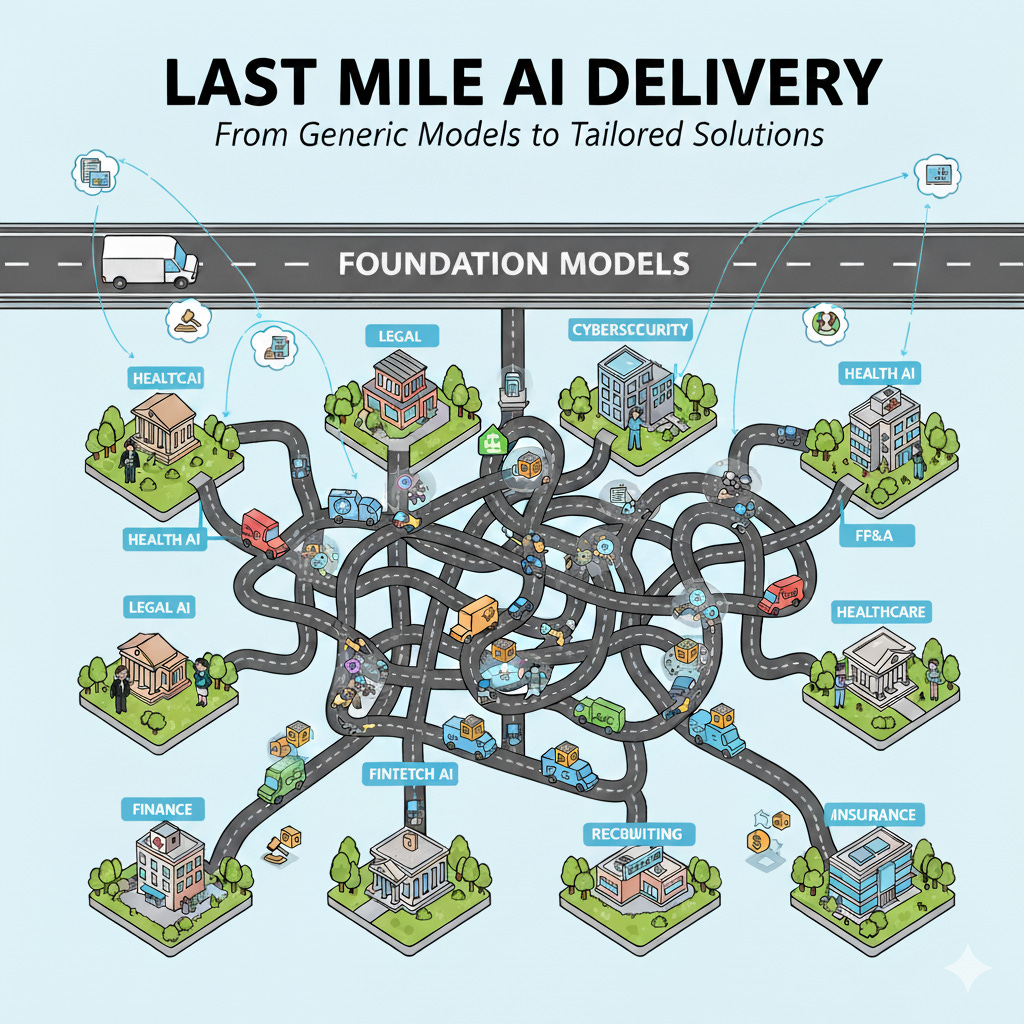Forget "GPT-Wrappers": The Future of AI Startups is Last-Mile Delivery
Why customer-obsessed, vertical-specific startups will win by delivering what foundation model labs can't
(Above is Gemini’s attempt to turn the below article into an image… we’re not at AGI yet).
The pace of innovation from foundation model labs like OpenAI, Anthropic, and Google is staggering. Every new release expands the horizon of what foundation models can do out of the box, prompting the question: if the models can do this much, where is the opportunity left for startups?
If you’re just competing on model performance, you’ve already lost.
The opportunity for startups isn’t in building a better base model. The opportunity is in building the “last-mile delivery” service that gets the power of these models to the customer’s front door, packaged in a way they can actually use.
This is the future of AI-native Application companies, which will almost certainly account for the vast majority of unicorns (and decacorns) being built right now.
Many VC’s constantly focus on technical differentiation in startups, wringing their hands about how each specific company can possibly stand up to OpenAI. In the world of applications, I think this risk is overblown, and I strongly doubt that OpenAI and Anthropic will ultimately become duopolies in every single vertical (if that happens, our society has bigger issues to deal with).
Classic economic moats will ALWAYS exist, and proprietary data is more important to business success than ever before.
Our core thesis is this: the AI labs will never build out the last-mile delivery needed to provide the best-in-class offering for every specific vertical, and they’ll never have access to the most valuable enterprise data that the best AI applications get to work with.
It’s too much work for them, it isn’t worth the time investment, and they’ll never be as close to customer problems as a focused startup can be. The labs are building the interstate highway system; the massive opportunity for startups is to build the local roads, the delivery vans, and the handheld scanners that get the package to the right person, at the right time, in the right way.
The “GPT-Wrapper” Fallacy
For the last few years, a debate has raged about “GPT-wrappers.” The term is almost always derogatory, implying a thin layer of UI on top of an API call, with no defensible value.
This line of thinking completely misses the point.
Our POV is that there is a ton of value created by really understanding a customer problem at a deeper level than anyone else. Being product-obsessed and customer-obsessed isn’t a “thin wrapper”; it’s the entire game. These are the products that will win out versus the generic, “good-enough” outputs from a horizontal model.
Take the Legal realm, for example. A company like Harvey isn’t trying to train a better LLM. They are maniacally focused on the “last mile” for lawyers.
They know exactly how lawyers need to see information.
They know what a specific law firm is focused on and how its workflows are structured.
They have access to the firm’s enterprise data, which they can use to provide tailored, high-stakes outputs.
Harvey wields the best-in-class models to provide an A+ end-user experience. That deep domain expertise is the moat. The model is the engine, but Harvey is building the whole car, the navigation system, and the white-glove driver service.
There are plenty of other examples of this in other application categories: Cursor in CodeGen, Abridge in medical scribing, Clay GTM, etc. All of these companies are wildly successful because they are closer to customer problems than anyone else, and have translated that into world class products with incredible last mile delivery (i.e., the bridge from 95% to 100%).
Where This Playbook Wins (and Where It Doesn’t)
This last-mile, vertical-first approach isn’t a silver bullet for every category. The success of this strategy is directly proportional to the “cost of being wrong.”
Where it will win (and build giant businesses):
Vertical-Specific Areas: Legal, finance, accounting, healthcare, etc. In these fields, the difference between a 95% correct answer and a 100% correct, context-aware answer is massive. It’s the difference between helpful and billable—or, in some cases, the difference between compliant and catastrophic.
Complex Horizontal Functions: CodeGen, customer support, recruiting, procurement, and cybersecurity. These are areas where a generic model output is just a starting point. A true solution needs to be deeply integrated into company-specific workflows, data, and policies.
Where this approach will likely be less successful:
“Good Enough” Categories: Think marketing copy generation, personal assistants, summarizing long documents. In these areas, a 90% “good enough” answer from a generic model is often plenty. The value of that last 10% isn’t high enough to justify a dedicated, vertical solution. The big, horizontal players will likely own these markets.
The Playbook for Winning the Last Mile
We believe enormous businesses will be built by teams who obsess over this last-mile delivery. Their success will depend on a few key factors:
Maniacal Customer Obsession: You must understand the customer’s problem better than they understand it themselves.
High Shipping Velocity: The product must evolve at the speed of the customer’s needs, not the model’s release schedule. Shipping speed is perhaps the single most important leading indicator of a startups success.
Access to Proprietary Data: The ability to (safely and with permission) leverage enterprise data is the key to moving from generic to specific.
Deep Trust: You are not just a software vendor; you are the trusted partner for a critical business function. This is especially true in high-stakes verticals.
Model Agnosticism: Always be willing and able to adopt the latest, most performant model from any lab. Your value is in the end-user experience, not the API you’re hooked up to.
The AI revolution won’t be delivered by a single, all-powerful model. It will be delivered by a generation of focused, product-driven startups.
The race to the customer’s doorstep is on.


